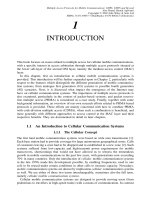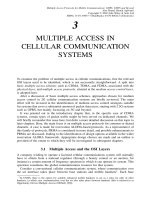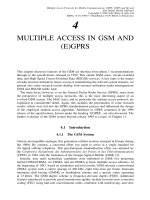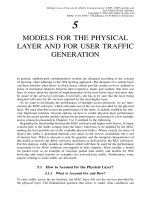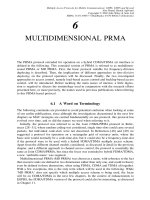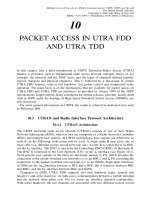Nhiều giao thức truy cập đối với truyền thông di động P9
Bạn đang xem bản rút gọn của tài liệu. Xem và tải ngay bản đầy đủ của tài liệu tại đây (220.93 KB, 19 trang )
Multiple Access Protocols for Mobile Communications: GPRS, UMTS and Beyond
Alex Brand, Hamid Aghvami
Copyright
2002 John Wiley & Sons Ltd
ISBNs: 0-471-49877-7 (Hardback); 0-470-84622-4 (Electronic)
9
MD PRMA WITH PRIORITISED
BAYESIAN BROADCAST
This last of the three chapters dealing exclusively with MD PRMA-related research results
finally treats scenarios that are not limited to voice traffic only. To assess the performance
of the prioritised Bayesian broadcast algorithm proposed in the following, a simulation
study for different mixtures of voice and data traffic is conducted, where the latter consists
either of Web traffic, email traffic, or a combination of the two. Preceding the discussion
of the simulation results, possible approaches to prioritisation at the random access stage
are evaluated, and a number of different algorithms which combine Bayesian broadcast
with prioritisation are presented.
9.1 Prioritisation at the Random Access Stage
The reader questioning the motivation for introducing prioritisation at the random access
stage is referred to Section 3.7, where this topic was treated in considerable detail, and
to the priority-class specific access control feature of GPRS described in Section 4.11.
UMTS provides also random access prioritisation, see Chapter 10.
For a mobile terminal to successfully send a channel request message in a given time-
slot, three events must occur simultaneously:
(1) there must be a random access slot (or C-slot, in the terminology used so far) in this
time-slot;
(2) the terminal must gain permission to access this slot; and
(3) the request packet transmitted in this slot must be successfully received by the base
station.
If the capture effect and transmission failures due to bad channel conditions are ignored,
the last event essentially means that the packet must not collide with another packet
transmitted in the same slot. Since the collision probability depends on how access to
C-slots is controlled, events (2) and (3) cannot be de-coupled. On the other hand, the
first event can be considered separately from the other two for the purposes considered
here
1
. If we want to introduce prioritisation at the random access stage to discriminate the
1
Strictly speaking, there is also a dependency between event one and the other two events. At a given arrival
rate, with increasing interval between C-slots, the number of newly arriving packets between two such slots
increases. Thus, the collision probability increases as well, if access to C-slots is not controlled adaptively.
330
9 MD PRMA WITH PRIORITISED BAYESIAN BROADCAST
access delay experienced by different priority classes, we therefore fundamentally have
two options. We could define different classes of C-slots, each class only to be accessed by
the respective priority class, and schedule these slots according to the QoS requirements
of the respective services associated with the different classes. Alternatively, we could let
all users access the same C-slots, but control the access to these slots according to the
priority class. High-priority users will obtain permission to access a certain C-slot with
higher probability than low-priority users. With the first approach, collisions do not occur
between users of different priority classes, with the second, they do.
Recall that with in-slot protocols such as MD PRMA considered here, every slot that
is currently not used for information transfer is a C-slot available for contention. Since
C-slots are not explicitly scheduled, the first approach to random access prioritisation does
not easily lend itself to MD PRMA. In the following, therefore, the focus is limited to the
second approach, namely service-class specific access control to a single class of C-slots.
In Sections 3.5 and 4.11, different approaches to access control for S-ALOHA protocols
and their derivatives were discussed. These are essentially:
• use of fixed permission probabilities;
• retransmission backoff schemes;
• stack-based schemes such as splitting or collision resolution algorithms; and
• (global) probabilistic access control such as Bayesian broadcast.
It is possible to introduce prioritisation with all these approaches. In the case of fixed
permission probabilities, different values can be chosen for different priority classes.
However, whether with or without prioritisation, stability problems are encountered with
such a scheme. With backoff schemes, prioritisation can be achieved by choosing priority-
class specific initial permission probability values (i.e. those relevant for the first trans-
mission attempt), but also class specific backoff rates.
It was reported in Section 3.5 that it is possible to exceed the 1/e throughput-limit of
S-ALOHA, for instance with tree-based collision resolution algorithms. This throughput
advantage is also maintained in prioritised versions of such protocols, as shown for
example in Reference [270] (for a selection of other relevant references in this field,
the reader is advised to consult Reference [271]). However, these stack-based algorithms
have the disadvantage of requiring immediate (although normally only binary) acknowl-
edgements to work properly, which, as discussed at length earlier, is difficult to achieve
in a real implementation.
Our interest in prioritisation was triggered by a submission to the ETSI SMG 2 GPRS
ad-hoc group responsible for the standardisation of the GPRS air interface [272]. In this
document, a prioritised pseudo-Bayesian broadcast algorithm with proportional priority
distribution between two priority classes was proposed for the GPRS random access. This
algorithm and subsequent enhancements are described in detail in the next section. In
Reference [55], we compared the performance of a four-class pseudo-Bayesian broadcast
algorithm with semi-proportional priority distribution with two other four-class algorithms.
The first one is based on exponential backoff, where, on top of priority-class specific initial
permission probabilities, as in Reference [273], the backoff rates chosen were also class
specific. The second one, a stack-based algorithm, was first proposed in Reference [274].
It is an enhancement of a two-class algorithm due to Stavrakakis and Kazakos [275] and
9.2 PRIORITISED BAYESIAN BROADCAST
331
supports an arbitrary number of priority classes. The Stavrakakis–Kazakos algorithm has a
maximum stable throughput from 0.32 to 0.357, depending on the traffic composition. We
found that the exponential backoff algorithm, while not requiring any feedback other than
acknowledgements, clearly performs worst, and exhibits stability problems. The Bayesian
algorithm outperforms the stack-based algorithm, and is (unlike the latter) inherently
fair, but may, depending on the chosen implementation, require slightly more signalling
overhead, since individual permission probabilities need to be conveyed to the terminals.
However, they need not necessarily be signalled for every slot (cf. Section 4.11). A
further advantage is that the proposed algorithm can easily be adapted for operation with
frame-based protocols.
With these considerations in mind, and given the successful adaptation of Bayesian
broadcast to MD PRMA discussed earlier, it cannot be a surprise that the prioritised
algorithm chosen for the following investigations is indeed based on Bayesian broadcast.
9.2 Prioritised Bayesian Broadcast
So far, the focus has been restricted to homogeneous voice traffic, thus for access control
only a single (access) permission probability value p
v
needed to be calculated. Consider
now the generic (single-class) permission probability value p calculated according to
the (pseudo-)Bayesian broadcast algorithm outlined in Subsection 6.5.4. In the following,
starting with the initial proposal in Reference [272] for two-class proportional priority
distribution, several algorithms will be introduced which, based on p, calculate individual
access probability values p
i
for each priority class i. Class 1 has highest priority, and voice
traffic is always assigned to class 1, thus p
v
= p
1
. Most of these algorithms were initially
proposed and investigated for S-ALOHA, but adaptation to MD PRMA is straightforward.
9.2.1 Bayesian Scheme with Two Priority Classes and
Proportional Priority Distribution
On a perfect collision channel as considered here, the optimum traffic level G
0
,atwhich
the throughput curve of S-ALOHA peaks, is G
0
= 1. Therefore, p should be chosen such
that the expected traffic assumes a value of one. If the estimated mean backlog v is equal
to the real backlog n, this is achieved by choosing
p = min(1,G
0
/v), (9.1)
as already pointed out in Section 6.5. For MD PRMA with A[t] C-slots in time-slot t,
the only modification required is that G
0
is now A[t].
In Reference [272] it was suggested to extend the Bayesian algorithm to support two
priority classes by assigning different transmission probabilities to the users of the high
and the low priority class based on p from the single-class scheme as follows:
p
1
= min(1,(1 + α) · p), (9.2a)
p
2
= α · p, (9.2b)
with the proportion of successfully received access bursts of class-two users to all users
α = S
2
/S, (9.3)
332
9 MD PRMA WITH PRIORITISED BAYESIAN BROADCAST
averaged over a suitable time-window. The degree of prioritisation cannot be chosen,
it is determined by α, which is why this approach was termed ‘proportional priority
distribution’ in Reference [272].
Provided that the backlog estimation is accurate, i.e. v ≈ n,andthatα reflects the
backlog proportion of low priority users to all users, which is n
2
/n (where n = n
1
+ n
2
),
the offered traffic G = p
1
· n
1
+ p
2
· n
2
assumes the value of the optimum offered traffic
G
0
, as desired. However, since p
1
>p
2
, the throughput proportion α is expected to
underestimate the backlog proportion n
2
/n. Interestingly, together with David Sanchez,
an M.Sc. student at King’s College London in 1995/1996, we found that while this is
indeed the case, at the same time also the backlog is underestimated. Taken together,
these two effects compensate in a manner which causes the offered traffic to assume its
optimum value all the same.
9.2.2 Bayesian Scheme with Two Priority Classes and
Non-proportional Priority Distribution
In an internal LINK ACS document, Jason Brown pointed out that the algorithm proposed
in Reference [272] could easily be extended to allow for non-proportional priority distri-
bution. This is achieved by choosing
p
1
= min(1,m· p), (9.4a)
p
2
= k · p, (9.4b)
with
m =
1 − α · k
1 − α
,(9.5)
and α as above. Either m or k can be chosen arbitrarily and thus used to control the
degree of prioritisation of high-priority users. In the following, k will be used as the main
prioritisation parameter.
9.2.3 Bayesian Scheme with Four Priority Classes and
Semi-proportional Priority Distribution
In 1996/1997, Celia Fresco Diez, an exchange student at King’s College London,
continued our earlier investigations on the GPRS random access. Some of her findings
are summarised in Reference [55]. The four-class semi-proportional algorithm described
here is due to her. In this algorithm, the permission probability values of the four classes
are set as follows:
p
1
= min(1,m· p), (9.6a)
p
2
= min
1,
2 · m + k
3
p
,(9.6b)
p
3
= min
1,
m + 2 · k
3
p
,(9.6c)
p
4
= k · p, (9.6d)
9.2 PRIORITISED BAYESIAN BROADCAST
333
with p and m as before and
α =
(S
2
/3) + 2 · (S
3
/3) + S
4
S
.(9.7)
The parameter k allows the delay spread between priority classes to be chosen, whereas
the degree of prioritisation between each priority class cannot be chosen individually,
which is why this approach was termed semi-proportional rather than ‘non-proportional’
priority distribution. The lower the value of k, the larger the difference between the
transmission probabilities and thus the stronger the degree of prioritisation. For k = 1the
algorithm degenerates to single-class Bayesian broadcast control.
9.2.4 Bayesian Scheme with Four Priority Classes and
Non-proportional Priority Distribution
In some cases, it may be desirable to control the degree of prioritisation for each class indi-
vidually. For Reference [52], we extended the above algorithm to a full non-proportional
algorithm according to the following:
p
1
= min(1,m· p), (9.8a)
p
2
= min
1,
z
1
m + z
2
k
z
p
,(9.8b)
p
3
= min
1,
z
2
m + z
1
k
z
p
,(9.8c)
p
4
= k · p, (9.8d)
with p and m as before. In this algorithm, k determines the delay spread between classes
1 and 4, while the parameters z
1
and z
2
, with z
1
>z
2
and
z = z
1
+ z
2
,(9.9)
determine the relative degree of prioritisation of classes 2 and 3. The relevant throughput
proportion must now be calculated as
α =
z
2
z
S
2
+
z
1
z
S
3
+ S
4
1
S
.(9.10)
Note that the semi-proportional algorithm is simply a special case of the non-
proportional algorithm with z
1
= 2andz
2
= 1. Under assumptions equivalent to those
made for the two-class proportional algorithm above, the offered traffic G is controlled
to the optimum traffic G
0
= 1, as desired. This can be verified through relatively simple
arithmetic, as shown in Reference [61, Appendix E].
In Subsection 3.7.4, a case was made for a centralised implementation of such access
control schemes, and the resources for downlink signalling required with such an approach
were discussed in Section 4.11. It was pointed out that the permission probability p would
have to be transmitted regularly (although not in every slot), but that a 4-bit resolution was
sufficient. On the other hand, with the structure of the prioritisation algorithm considered
here, m (which fluctuates with α, which in turn depends on the chosen time-window
334
9 MD PRMA WITH PRIORITISED BAYESIAN BROADCAST
for averaging) can be broadcast less frequently. Finally, only infrequent signalling of
values for k, z
1
,andz
2
is required. Obviously, exploiting the structure of a specific
algorithm to reduce signalling load means limited flexibility once the system is deployed.
By contrast, if p
1
to p
4
were signalled individually (e.g. by three to four bits each), a
network operator could change the algorithm arbitrarily through a software update at the
base station, without affecting mobile terminals already in use.
9.2.5 Priority-class-specific Backlog Estimation
The algorithms proposed above have the two following things in common.
(1) No attempt is made to estimate the backlog of individual priority classes separately,
instead, the backlog proportion is estimated based on the total estimated backlog
and the throughput proportion.
(2) The individual permission probability values are expressed as a function of the
single-class permission probability value G
0
/v.
While the second feature is deliberate to limit the signalling overhead required on
the downlink, as just discussed, the first was initially identified as a shortcoming of
these algorithms, which one might wish to overcome. However, since we found that, for
S-ALOHA, the average access-delay performance over all classes with these prioritised
algorithms exactly matched the performance of the single-class algorithm, we did not
invest any further effort in attempting to estimate the backlog of each class individually.
In the mean time, Frigon and Leung proposed in Reference [271] a prioritised version
of Bayesian broadcast for x priority classes, which relies on such individual backlog
estimation. In this algorithm, a prioritisation parameter γ
i
can be selected for each priority
class individually, which in turn determines the access permission probability to be used
for each class through p
i
= min(1,γ
i
/v
i
).Sinceγ
i
can be viewed as the expected offered
traffic for each class, the sum over all xγ
i
-values must amount to G
0
= 1. If for any
class v
i
<γ
i
in any given slot, and p
i
were simply set to min(1,γ
i
/v
i
), the expected
total offered traffic in that slot would be less than one, which is not optimum. Frigon and
Leung account for this fact, and assign such leftover capacity to other priority classes (in
order of priority) by temporarily increasing the traffic fraction assigned to these classes.
Doing so ensures that low priority users send their packet immediately, if currently no
high priority users are backlogged and, conversely, that no capacity is reserved for low
priority users if there are none. Taking it to the extreme, γ
x
can be set to zero, such that
the lowest priority class obtains only ‘leftover capacity’. This improves the average delay
performance compared to the single-class algorithm slightly, and thus also compared to
the algorithms we proposed above. To exploit this performance advantage, the backlog
needs to be estimated for each class individually, an extra effort which could well be
justified. As a further attractive feature, this algorithm could also be extended by setting
γ
1
adaptively given v
1
, to help meeting a specific desired access delay performance for
class 1 (as a result, γ
2
..γ
x
would obviously also need to be readjusted). However, it
would not be possible to link p
i
to p any more as in Equation (9.8). Instead, individual
9.2 PRIORITISED BAYESIAN BROADCAST
335
p
i
values would have to be signalled for every time-slot carrying C-slots, adding overhead
on the downlink.
Rivest’s derivation of the pseudo-Bayesian broadcast algorithm in Reference [51] is
based on the assumption that the arrival process of newly generated packets is Poisson,
and the same also holds true for all prioritised versions of this algorithm. Frigon and
Leung therefore looked at the impact of non-Poisson arrivals, by assessing the performance
of their algorithm with self-similar traffic in Reference [271]. While self-similar traffic
resulted, not surprisingly, in increased total average access delay, they found that their
algorithm still reduced effectively the average access delay of the high-priority users. This
is consistent with our findings reported later for email and Web traffic, which is similar
in nature to the traffic Frigon and Leung considered.
9.2.6 Algorithms for Frame-based Protocols
In Reference [271], Frigon and Leung adapted their prioritised algorithm also for frame-
based protocols, that is, TDD protocols with a single switching-point between link direc-
tions per TDMA frame. In this modified algorithm, every mobile terminal may pick only
one C-slot per TDMA frame. This seems also to be the case in the PRMA/TDD protocol
proposed by Delli Priscoli in Reference [161], which also features adaptive and priority-
class dependent parameter calculation for access control (but the parameter calculation
is not based on Bayesian reasoning, instead it relies heavily on the knowledge of traffic
statistics). Compared to the frame-based FRMA protocol discussed in Section 6.3, where a
terminal is allowed to contend repeatedly in a frame before receiving acknowledgements,
this approach increases access delay unnecessarily. We believe therefore that terminals
should be allowed to contend more than once per frame. With the semi-proportional
and non-proportional prioritisation algorithms discussed above and the adaptation of the
single-class Bayesian broadcast algorithm to FRMA described in Subsection 6.5.6, all
tools required for prioritisation with FRMA are available.
Since every terminal is allowed to contend repeatedly in a frame, it is expected that
rather low values will need to be chosen for the prioritisation parameter k in Equation (9.6)
or (9.8) to achieve worthwhile access delay discrimination. This is because with FRMA, as
with every frame-based protocol, access delay discrimination through access control alone
can only be achieved in terms of multiples of the TDMA frame duration. To influence
the delay behaviour beyond the resolution of an entire frame, appropriate priority-class
dependent resource allocation algorithms could be added (for instance, the time-slots at
the start of a frame could be assigned to high-priority users with preference).
Note that both the slot-based and frame-based protocols considered in Reference [271]
are purely contention-based. By contrast, both the slot-based MD PRMA protocol and
the frame-based MD FRMA protocol (the latter not being investigated any further here)
are reservation-based, as they belong to the family of in-slot R-ALOHA protocols (cf.
Subsection 3.6.4). Finally, the PRMA/TDD protocol in Reference [161] is an out-slot
R-ALOHA protocol, which not only features adaptive parameter calculation for the C-
slot permission probability, but also adaptive calculation of the required number of C-slots
in each frame to guarantee a certain success probability. This in turn affects the position
of the switching-point between link directions.
